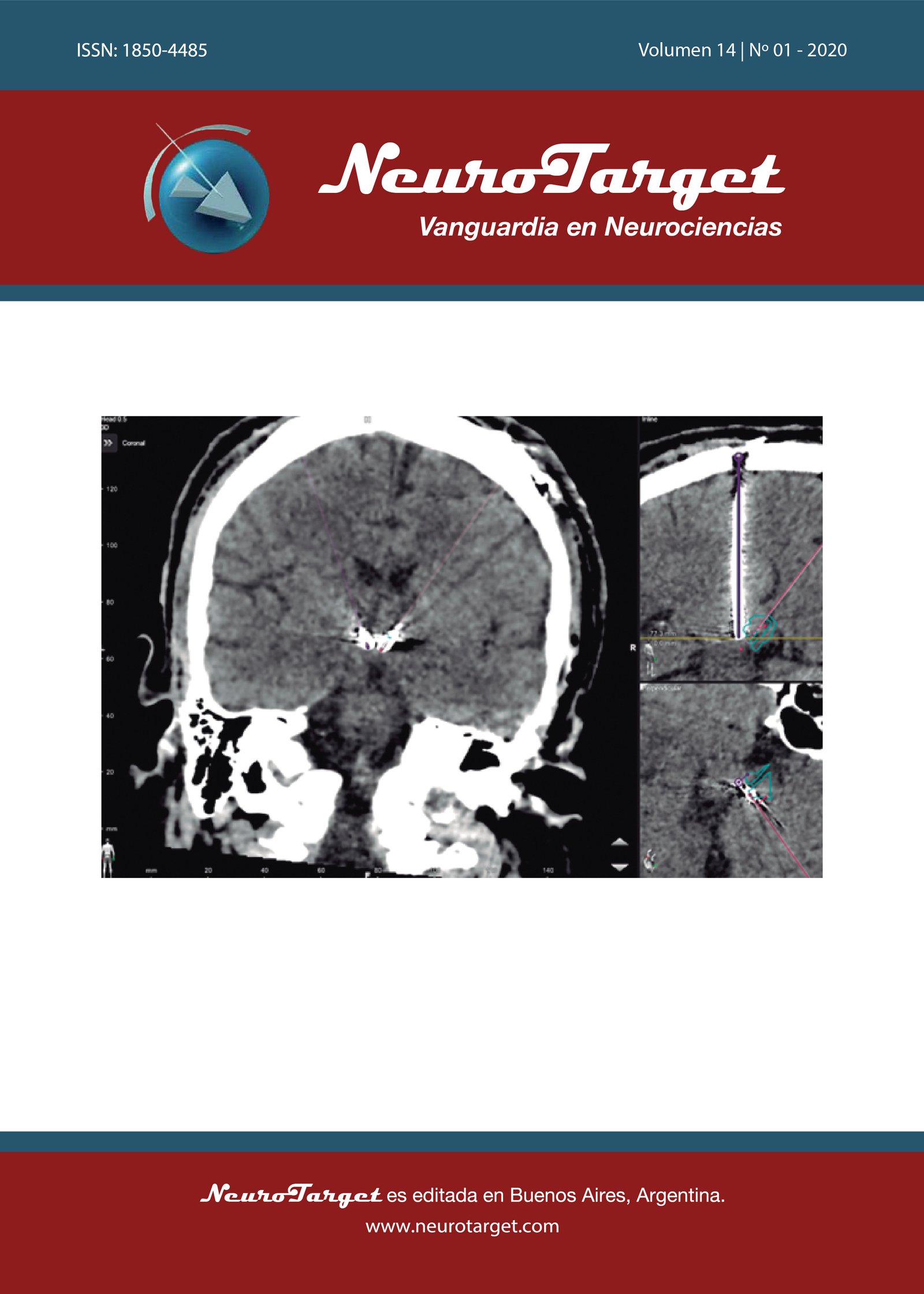Fundamentos Neuroanatómicos y Neurofisiológicos de la Región Hipotalámica para su Tratamiento Neuroquirúrgico Estereotáctico. Su importancia para la terapéutica de la obesidad mórbida refractaria.
DOI:
https://doi.org/10.47924/neurotarget202068Palabras clave:
Diencéfalo, estimulación cerebral profunda, glándulas endócrinas, hipotálamo, obesidad mórbidaResumen
Introducción: El hipotálamo es de una riqueza anátomo – funcional destacable. Está dividido en dos grandes regiones, anterior y periventricular y presenta conexiones con la región temporal, la vía óptica, a la vez de conexiones privilegiadas con la hipófisis.
Discusión: Este núcleo juega un rol esencial en la memoria, la generación del sueño, los ciclos circadianos y principalmente en la homeostasis del peso corporal.
Conclusión: En este trabajo monográfico realizamos una descripción anatómica y funcional de esta estructura, con énfasis final en la descripción de su empleo para el tratamiento de la obesidad mórbida refractaria.
Métricas
Citas
Barbosa DAN, De Oliveira-Souza R, MonteSanto F, De Oliveira Faria AC, Gorgulho A A and De Salles AAF. The hypothalamus at the crossroads of psychopathology and neurosurgery. Neurosurg. Focus. 2017; 43:E15.
Spieguel EA, Wycis HT, et al. Thalamotomy and hypothalamotomy for treatment of psychosis: psychiatric tratment. Res Publ Assoc Res Nerv Ment Dis. 1953; 31:379 391.
Patestas MA and Gartner LP. A Texbook ofNEUROANATOMY. Chapter 21 Hypothalamus Pag. 361 – 362, 368-370. Blackwell Publishing Ltd, 2006.
Barr ML, Kierman, JA. El Sistema nervioso humano. Un punto de vista anatómico. 4ta Edición. Ed Harla (México) 1983, pp 214 -9.
Barr ML, Kierman JA. El Sistema nervioso humano. Un punto de vista anatómico. 4ta Edición. Ed Harla (México) 1983, pp 211-4.
Schaltenbrand G, Wahren W, Hassler R: Atlas for stereotaxy of the human brain, in: Atlas for Stereotaxy of the Human Brain, ed 2. Stuttgart: Thieme, 1977, p 84.
Williams G, Bing C, Cai XJ, Harrold JA,King PJ, Liu XH. The hypothalamus and the control of energy homeostasis: Different circuits, different purposes. Physiol. Behav. 2001; 74: 683–701.
Elmquist JK, Elias CF, Saper CB. Fromlesions to leptin: hypothalamic control of food intake and body weight. Neuron.1999; 22:221–232
Simpson KA, Martin NM, Bloom SR. Hypothalamic regulation of food intake and clinical therapeutic applications. Arq. Bras. Endocrinol. Metabol. 2009; 53:120–128
Franco R, Fonoff ET, Alvarenga P, Lopes AC, Miguel EC, Teixeira MJ, Damiani D and 2016; 6(21):1-9
Stuber GD, Wise RA. Lateral hypothalamic circuits for feeding and reward. Nat. Neurosci. 2016; 19:198–205
Taghva A, Corrigan JD, Rezai AR: Obesity and brain addiction circuitry: implications for deep brain stimulation. Neurosurgery. 2012; 71:224–238
Anand BK, Brobeck JR: Localization of a “feeding center” in the hypothalamus of the rat. Proc Soc Exp Biol Med. 1951; 77:323– 324
Montemurro DG, Stevenson JA: The localization of hypothalamic structures in the rat influencing water consumption. Yale J Biol Med. 1955; 28:396–403
Messiah SE, Lipshultz SE, Natale RA, Miller TL: The imperative to prevent and treat childhood obesity: why the world cannot afford to wait. Clin Obes. 2013; 3:163–171
Dupré DA, Tomycz N, Oh M Y and Whiting D. deep brain stimulation for obesity: past, present, and future targets. Neurosurgical Focus. 2015; 38(6):1-9
Hamani C, McAndrews MP, Cohn M, Oh M, Zumsteg D, Shapiro CM, et al: Memory enhancement induced by hypothalamic/ fornix deep brain stimulation. Ann Neurol. 2008; 63:119–123
Wilent WB, Oh MY, Buetefisch CM, Bailes JE, Cantella D, Angle C, et al: Induction of panic attack by stimulation of the ventromedial hypothalamus. J Neurosurg. 2010; 112:1295– 1298
Hetherington, AW and Ranson SW. Hypothalamic lesions and adiposity in the rat. Anat. Rec. Banner. 1940; 78:149-72
Lemaire JJ, Nezzar H, Sakka L, Boirie Y, Fontaine D, Coste A, et al. Maps of the adult human hypothalamus. Surg. Neurol. Int. 2013; 4: S156–S163
Sani S, Jobe K, Smith A, Kordower JH, Bakay RA: Deep brain stimulation for treatment of obesity in rats. J Neurosurg. 2007; 107:809–813
Whiting AC, Tomycz ND, Bailes J, de Jonge L, Lecoultre V, Wilent B, et al: Lateral hypothalamic area deep brain stimulation for refractory obesity: a pilot study with preliminary data on safety, body weight, and energy metabolism. J Neurosurg. 2013; 119:56–63
Whiting AC, Oh MY and Whiting DM. Deep brain stimulation for appetite disorders: a review. Neurosurg Focus. 2018; 45(2):1-6
Talakoub O, Paiva RR, Milosevic M, et al. Lateral hypothalamic activity indicates hunger and satiety states in humans. Ann Clin Transl Neurol. 2017; 4(12):897-901
Sakurai T: Roles of orexins in the regulation of body weith homeostasis. Obes Res Clin Pract. 2014; 8:e414 - e420
Wheeler DS, Wan S, Miller A, Angeli N, Adileh B, Hu W, et al. Role of lateral hypothalamus in two aspects of attention in associative learning. Eur J Neurosci. 2014; 40:2359–2377
Cavadas C, Aveleira CA, Souza GF, and Velloso IA. The pathophysiology of defective proteostasis in the hypothalamus from obesity to ageing. Nat Rev Endocrinol. 2016;12 723733
Descargas
Publicado
Cómo citar
Número
Sección
Licencia
Derechos de autor 2020 Guillermo A. Larrarte

Esta obra está bajo una licencia internacional Creative Commons Atribución 4.0.
Este artículo se distribuye bajo la licencia Creative Commons Attribution 4.0 License. A menos que se indique lo contrario, el material publicado asociado se distribuye bajo la misma licencia.







